Formnext 2018: The global AM industry addresses ‘the bigger picture’ for true industrialisation
From November 13-16, 2018, the Additive Manufacturing world congregated in Frankfurt, Germany, to attend the year’s final and arguably most significant international exhibition on the technology. Occupying more than 37,000 m2 of floor space, Formnext 2018 attracted nearly 27,000 visitors - an increase of more than 25% on the previous year - and over 600 global exhibitors. In this report, Metal AM’s Emily-Jo Hopson covers some of the news and developments out of Formnext, and looks at how they reflect an industry turning its focus toward productivity and efficiency for true industrialisation. [First published in Metal AM Vol. 4 No. 4, Winter 2018 | 30 minute read | View on Issuu | Download PDF]
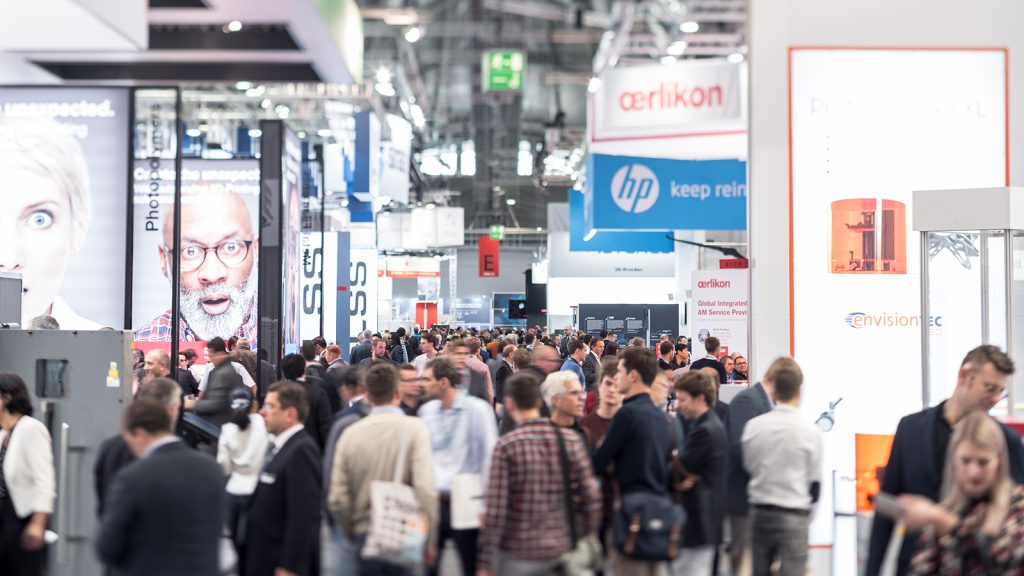
Since its launch in 2015, Formnext has seen significant year-on-year expansion and solidified its status as the leading international trade fair for Additive Manufacturing. Each year, the show attracts both engineers and management from a wide range of world-renowned companies including leading OEMs and suppliers in the aerospace, automotive, oil and gas, medical, dental, mechanical engineering and the construction and architectural industries. Whilst the industry’s leading players dominated the event’s two halls, Formnext’s organisers once again provided an essential platform for start-ups and other lesser-known AM companies to gain significant exposure before a truly global audience.
As has now come to be expected, Formnext was host to a number of major industry announcements, business deals and machine sales which will set the course for the continued development of the AM industry over the coming twelve months. However, while former events have seen companies competing to announce ‘the world’s biggest machines’ with ‘the world’s largest number of lasers,’ the focus at Formnext 2018 was on how such a machine – however exciting the technology it offers – should fit into the overall workflow of a functioning production line, and how such production lines can find a place in the global industrial landscape. Throughout the event, companies sought to demonstrate how they were tackling this question through a combination of machine launches and updates, software integrations, development programmes centred on the ‘factory of the future’ and more.
In other words, Formnext 2018 was the exhibition for ‘the bigger picture’, at which the focus was widened from single machine to functioning production line. Exhibits, discussions and product launches leaned heavily toward increased productivity and efficiency (through faster production, decreased waste, integrated process steps, etc), cost-per-part affordability, factory integration, modularity and more. An increasing rate of adoption and collaboration throughout the industry could also be observed. As has been visible at most industry events throughout 2018, the concept of the ‘digital factory’ or ‘smart factory’ was highlighted by many companies as key to the success of AM as a mature production technology. Major players such as EOS, SLM Solutions, GE Additive and Trumpf, to name just a few, were keen to demonstrate their plan to implement a truly digital, automated workflow soon, with many having established pilot digitalised production lines since 2017.
It would be difficult to cover every announcement from the metal AM industry at Formnext in this report; the list is extensive, ranging from peripheral solutions to major product launches. Those announcements which are not included here can be found in this magazine’s Industry News section. Here, we will focus on some of those developments which were the most highly reflective of the industry’s maturation toward real-world productivity.
Machine makers target productivity at volume
ExOne’s X1 25PRO™: MIM powder capability for volume production
During Formnext, The ExOne Company, North Huntingdon, Pennsylvania, USA, announced its newest system, the X1 25PRO (Fig. 2). Combining the capabilities of ExOne’s small-scale Innovent+™ machine with series production capacity, the new X1 25PRO is said to be positioned to address the needs of Metal Injection Moulding, Powder Metallurgy and other manufacturing customers seeking a larger platform solution for the manufacture of parts in a production environment.
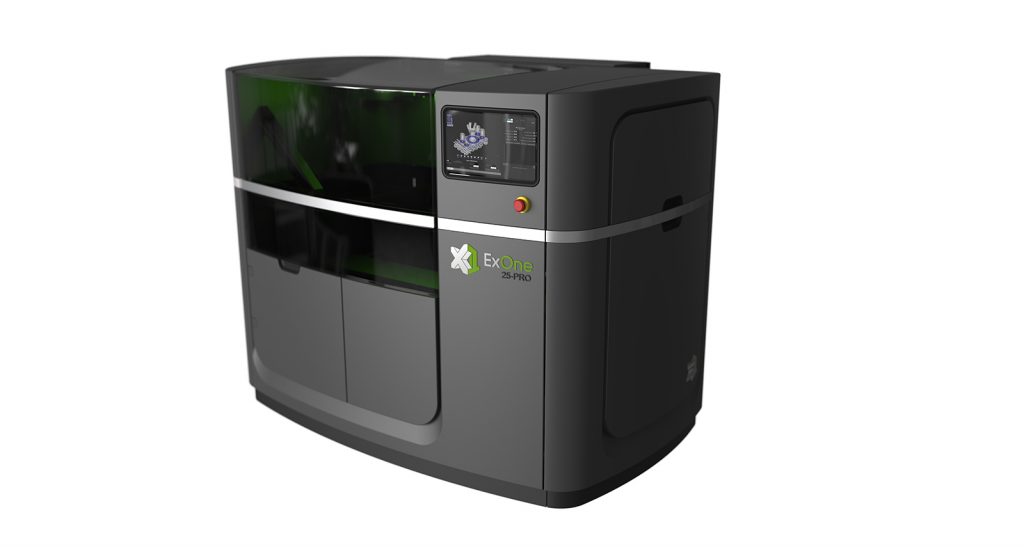
The new system offers the ability to produce high quality parts from a variety of materials including: 316L, 304L, and 17-4PH stainless steels; Inconel 718 and 625; M2 and H11 tool steels; cobalt chrome; copper; tungsten carbide cobalt and many other types of powder. Speaking on the system’s launch during the exhibition, Rick Lucas, ExOne’s Chief Technology Officer, stated, “We are pleased to bring the new X1 25PRO to market to satisfy the needs of the industry for high quality, functional, production-volume parts. ExOne has a pioneering legacy of being on the cutting edge of introducing materials and processes using Binder Jetting.”
“We currently have machines installed in customer facilities in more than twenty countries around the globe, and we are proud to bring innovations like the X1 25PRO to realisation,” he continued, adding: “This is the first of two machines that we are introducing by the end of the first half of 2019, utilising our state-of-the-art, patent pending MIM powder processing machine technologies. We believe these new production machines will be the most flexible and highest performing Binder Jetting machines in the market.”
Triditive: Hybrid and automated Additive Manufacturing with AMCell®
Triditive, an Additive Manufacturing machine maker based in Gijón, Spain, presented its AMCell, a hybrid and automated Additive Manufacturing machine said to be capable of producing up to 10,000 parts per month using BASF’s Ultrafuse 316LX filament (Fig. 3). Enabled by its control software and remote monitoring, the integrated system is aiming to make Additive Manufacturing a viable solution for high-volume manufacturing, 24/7.
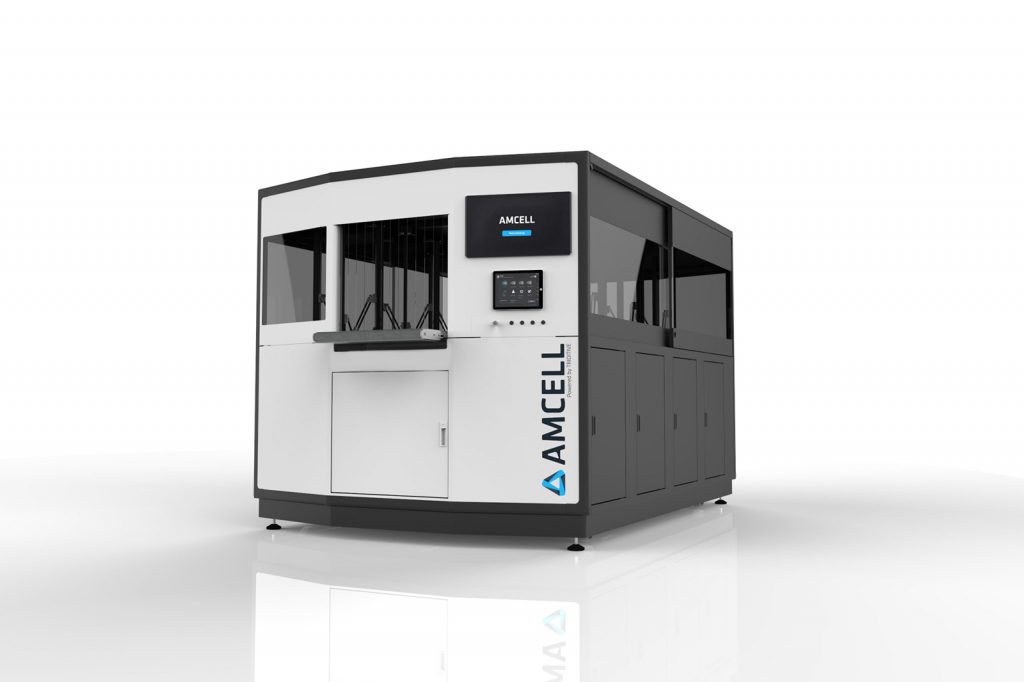
According to Mariel Diaz, Triditive CEO, “The green parts printed with AMCell using BASF’s metal filament solution meet the geometric and surface quality requirements for mass manufacturing of final parts. The controlled build chamber environment in the AMCell and its optimised extrusion process achieve part porosities similar to those that are typically obtained from Metal Injection Moulding technology.”
AMCell’s automated manufacturing of large batches and use of Ultrafuse 316LX is said to greatly ease material handling processes by eliminating the potential hazards inherent to metal powder-based AM processes. The automatic load and consumption control of Ultrafuse 316LX filament spools allows the system to operate largely unsupervised throughout the production process, and reduces human labour and intervention to a minimum during production, though the green parts produced must undergo debinding and sintering in line with BASF’s widely used Catamold MIM feedstock.
3D Systems: Latest additions to the DMP platform unveiled
3D Systems, South Carolina, USA, announced the latest additions to its DMP metal Additive Manufacturing platform – the DMP Flex 350 and DMP Factory 350 (Fig. 4). These systems are designed for the volume metal AM of critical components for industrial applications such as aerospace, healthcare, and transportation. In addition to these systems, the company introduced a new aluminium alloy material – LaserForm® AISiMg0.6(A).
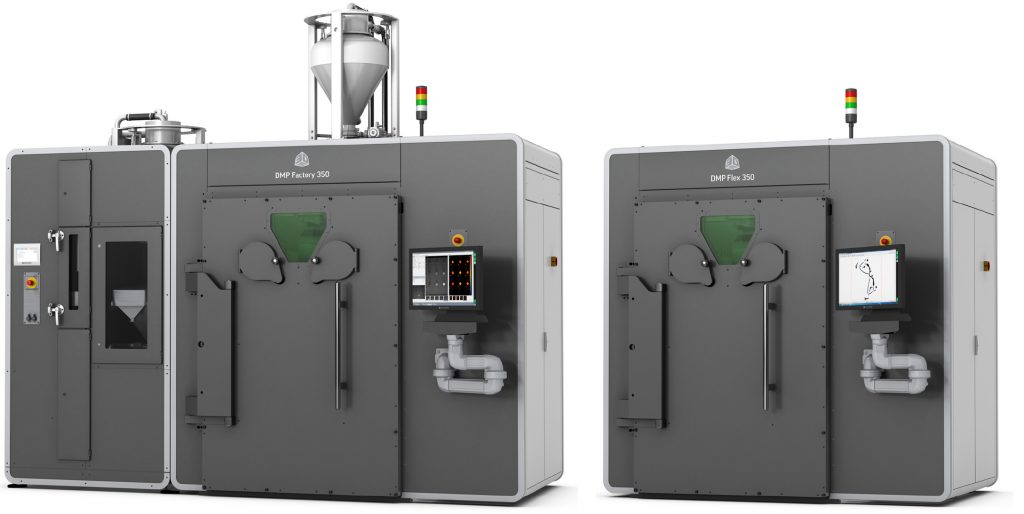
These latest launches follow relatively close on the heels of the announcements of the DMP Flex 100 in June 2018 and the DMP Factory 500, developed in partnership with GF Machining Solutions, in September 2018. The new DMP Factory 350 and DMP Flex 350 are said to provide a strategic migration path that enables customers to grow their business by transforming the way they design and manufacture parts. These are systems engineered for robust, repeatable 24/7 metal part production for R&D, application development and production, and the DMP platform’s design enables customers to scale from the Flex 350 to the Factory 350 as their production needs evolve.
The DMP Flex 350 was described by 3D Systems during the show as the successor to its ProX DMP 320 machine, enabling more efficient production of very dense, pure metal parts and incorporating improved gas flow technology for more uniform part quality across the entire build area. Additionally, the new system offers an improved build productivity of 15% over the previous model, facilitating faster times to market at lower total operation costs. For enhanced ease-of-use for demanding production environments, the DMP Flex 350 can be field upgraded to the DMP Factory 350. The DMP Factory 350 combines the same features and advantages of the DMP Flex 350 with integrated powder management. The DMP Factory 350 also includes real-time process monitoring via 3D Systems’ DMP Monitoring and allows customers to analyse and optimise parameters for higher quality final parts.
Desktop Metal: An enhanced Production System for high-volume AM
Desktop Metal, Massachusetts, USA, announced several major advancements and expanded capabilities to its Production System, the company’s metal Additive Manufacturing machine developed for the mass production of complex metal parts (Fig. 5). The company also displayed a range of metal AM parts produced on the new system. The installation of the first Production System is scheduled for the first quarter 2019 at a Fortune 500 company which was among Desktop Metal’s early ‘Pioneer customers’, the first wave of companies to place orders for its systems, with additional installations set to follow at major automotive and metal parts manufacturers throughout 2019 and broad customer availability expected in 2020.
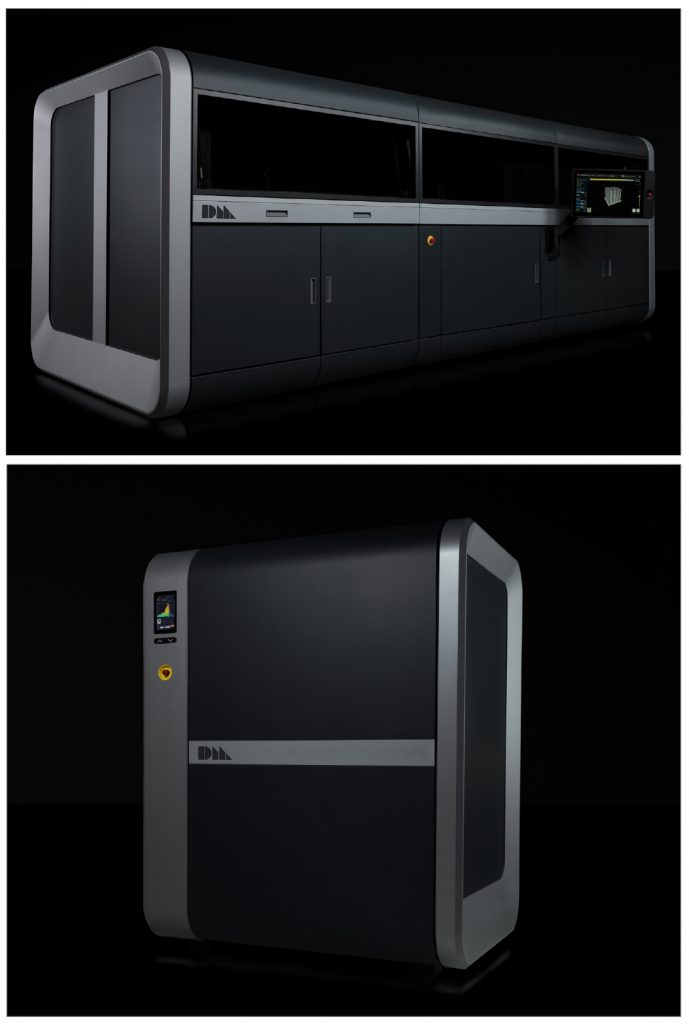
Ric Fulop, CEO and co-founder of Desktop Metal, commented during Formnext, “As we continue to expand our list of global customers and partners, with companies turning to the game-changing technology available with the Production System and installations set to begin rolling out in the coming months, Desktop Metal is looking to further shift the industry beyond prototyping to now include full-scale metal manufacturing.”
Powered by what Desktop Metal calls its Single Pass Jetting technology, the Production System is said to offer a ‘one hundred times speed improvement over any laser-based system.’ Since it was first introduced, the technology and capacity of the Production System have expanded to include accelerated build speeds of up to 12,000 cm3 per hour; a 225% larger build volume of 750 x 330 x 250 mm; two full-width print bars, advanced powder spreaders and an anti-ballistic system that work to spread powder and print in a single quick pass across the build area; and the use of 32,768 piezo inkjet nozzles that enable binder chemistries to build parts from a wide range of metals – including tool steels, low-alloy steels, titanium and aluminium – at a rate of three billion drops per second. The Production System also offers an industrial inert environment, including gas recycling and solvent recovery, to safely additively manufacture reactive metals in mass production, and the capability to build more than 60 kg of metal parts per hour.
The parts exhibited by Desktop Metal at its stand included a mass-produced batch of Milwaukee Tool spauger bits, which feature a complex geometry traditionally requiring multiple manufacturing steps to produce. Producing each individual bit conventionally involves twenty time-consuming process stages, including milling, turning and grinding. Using the Production System, Desktop Metal has been able to reduce the number of steps to four, and can produce as many as 1,400 spauger bits for every four-hour build.
GE Additive: Concept Laser M Line Factory systems to ship Q2 2019
While GE Additive did not bring a major machine launch to Formnext, the company announced during the show that the first Concept Laser M Line Factory systems will be delivered to customers in the second quarter of 2019 (Fig. 6). Since GE Additive’s acquisition of Concept Laser in December 2016, the M Line Factory’s design architecture, system and software have undergone extensive review and redesign in line with established GE processes and beta testing with selected customers. Jason Oliver, President & CEO of GE Additive, stated, “The positive impact the M Line Factory can have on our customers’ operations and their bottom line is huge. It’s important we provide technologically advanced systems that are reliable and add value to our customers. M Line Factory delivers on those commitments.”
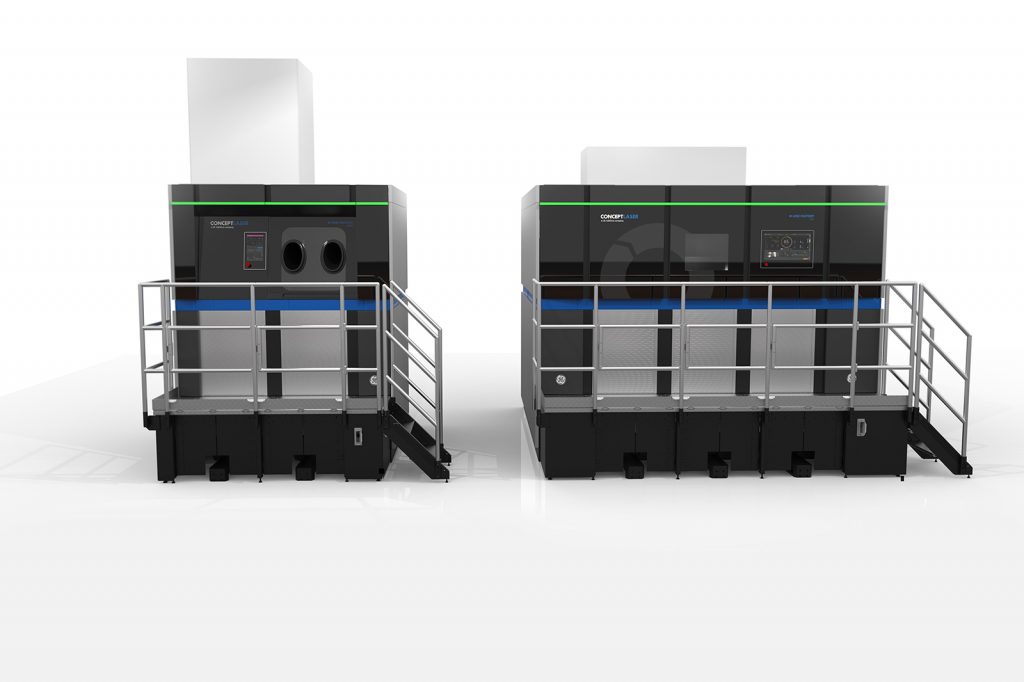
The M Line Factory automates both upstream and downstream stages of the production process and provides interfaces to conventional manufacturing methods in the form of automation, interlinking and digitalisation. As Additive Manufacturing transitions from a prototyping to a production technology, the demand for machines increases, as does the demand on production floor space and the number of operators required to run production lines. Existing standalone machine solutions can limit economical series production, but GE is confident that the M Line Factory’s modular machine architecture can offer outstanding automation and reliability, driving economical and scalable series production on an industrial scale.
GE added that during detailed rig testing and lifetime testing, a number of areas were identified for improvement and have since been incorporated into the system, including improved in-machine architecture and automation; a scalable modular system design; an increased build volume of 500 x 500 x up to 400 mm³ (x,y,z); and a modularised onboard software architecture offering superior exposure strategies and real-time, in-situ process monitoring; and enhanced process control & thermal stability to enable the control of key process variables that can dictate part quality.
Part production, as well as the set-up and dismantling process, takes place in two independent machine units which can be operated separately from one another or combined depending on each customer’s preference. This enables production processes to run in parallel rather than sequentially, thereby reducing downtime considerably and increasing the availability and output quantity of the process chain.
New software releases aim to speed design and enhance production management
Siemens: Additive Manufacturing process simulation for improved accuracy
Throughout 2018, Siemens has made a number of significant announcements regarding its activities in AM, from the news that its metal AM gas turbine burner has completed its first year of operation, to the successful testing of new applications such as a metal AM gas turbine pre-mixer, to its £27 million investment in a new Materials Solutions facility for AM in Worcester, UK (see page 7), to the development of a new advanced depowdering system, the SFM-AT800S, in partnership with Solukon Maschinenbau GmbH. During Formnext, the company showcased the integrated AM solutions it offers under the tagline ‘Industrialize Additive Manufacturing’. Siemens sought to highlight its ability to tailor its solutions portfolio to its customers’ respective industries, from automotive to mechanical engineering, using an apparently seamless development process chain suitable for use with all common AM processes and systems, which covers steps from part design to the creation of build exposure paths on an associative database.
The main announcement from Siemens was the addition of a new, integrated process simulation tool designed specifically for Laser Beam Powder Bed Fusion (LB-PBF) AM. The Simcenter™ 3D AM Process Simulation tool uses a digital twin to simulate the build process prior to building a part, anticipating distortion within the process and automatically generating the correct geometry to compensate for those distortions (Fig. 7).
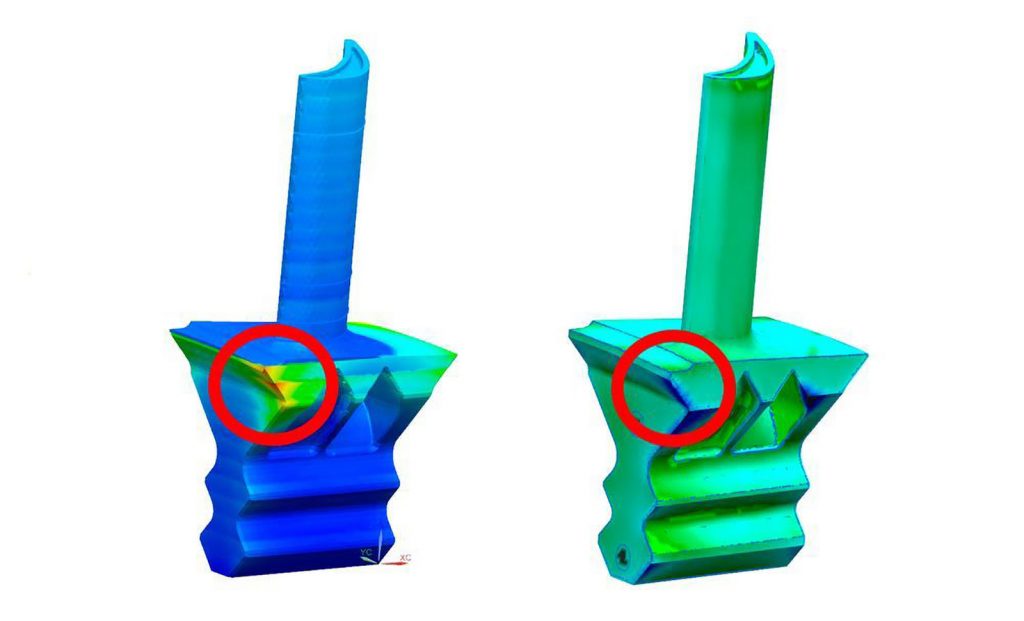
The ability to simulate part distortion during LB-PBF is key to the fabrication of ‘first time right’ components, and a necessary step if manufacturers are to achieve the efficiencies required to fully industrialise metal Additive Manufacturing. The new tool is integrated into the Powder Bed Fusion Process Chain in the Siemens PLM Software Additive Manufacturing portfolio, providing a guided workflow to the user that allows for the assessment of distortions, the prediction of recoater collisions, prediction of areas of overheating, and other important feedback about the build process. It offers the ability to iterate on a solution between the design and build tray set-up steps of the workflow, and the simulation step. The simulation data created then feeds into the digital thread of information gathered by the system, which informs each step of the build process. This enables the system to develop pre-compensated models and to feed those seamlessly back into the model design and manufacturing processes without additional data translation.
3YOURMIND: Product scheduling software for fully-integrated and automated AM
3YOURMIND GmbH, Berlin, Germany, announced the launch of its latest product, titled the Agile Manufacturing Execution System (Agile MES), a production scheduling platform developed to manage the scheduling and prioritisation of additively manufactured parts. The initial features showcased during Formnext were what the company refers to as Smart Part Prioritisation and Agile Production Scheduling. According to the company, the most significant improvement for AM service managers on the production floor is provided by a data based recommendation engine; when AM jobs are created, the system automatically suggests which parts to assign and when to assign them.
The company stated that it has “an aggressive road-map” in place to develop the Agile MES further based on the requirements of its customers. Stephan Kühr, Co-founder of 3YOURMIND, explained, “Our next priority is to create a strong direct connection from the Agile MES to individual machines. The collection of the real-time production data will further enable accurate production tracking and quality assurance. We are determined to generate a fully integrated and automated platform that can serve as the data infrastructure for the factory of the future.”
AddUp and ESI Group: Distortion Simulation AddOn for metal AM
Fives and Michelin joint venture AddUp, Clermont-Ferrand, France, announced during Formnext the forthcoming availability of a Distortion Simulation AddOn, developed jointly with ESI Group, Paris, France. This module, specifically designed for metal Additive Manufacturing, is designed to enhance the functionalities of the AddUp Manager software for the definition and production tracking of parts. The Distortion Simulation AddOn is set for commercial launch in Spring 2019.
As founding members of France’s SOFIA project (Solution pour la Fabrication Industrielle Additive métallique – Industrial Metal Additive Manufacturing Solution), initiated in 2016 and sponsored by Bpifrance, AddUp and ESI Group stated that they have shared a “common vision of metal Additive Manufacturing” since their first meeting. At a time when the industrialisation of AM is drawing closer to reality, both companies noted that simulation based on material physics, which ensures an in-depth understanding of material processes and behaviour, is one of the key components to improving the competitiveness of the AM process.
The optimisation of process parameters is a crucial stage in the AM process; manufacturers, according to their specific applications, must be able to focus available machine times either on production or on process optimisation. Traditionally, production validation has primarily meant producing parts, then assessing their conformity. Introducing a simulation tool all too often limited expert users and required multiple feedback loops between different functions, creating discontinuity over the digital chain. By integrating simulation directly in the preparatory stages of the AM process, the new Distortion Simulation AddOn is said to bring continuity to the technology, while the AddUp Manager’s user interface is designed to be both intuitive and stable, offering a good working environment in which to define simulation parameters, particularly for staff who are not experts in this field.
Simufact Additive 4: Simulation for the entire AM process chain
Simufact, an MSC Software Company headquartered in Hamburg, Germany, released Simufact Additive 4 – the newest generation of its solution for the simulation of metal Additive Manufacturing processes – during Formnext (Fig. 8). This scalable, practitioner-oriented simulation solution is designed to predict distortion, stress and temperature effects, and help to optimise build preparation, build simulation and subsequent steps in the AM process chain, including steps such as heat treatment, build plate removal, support removal and Hot Isostatic Pressing.
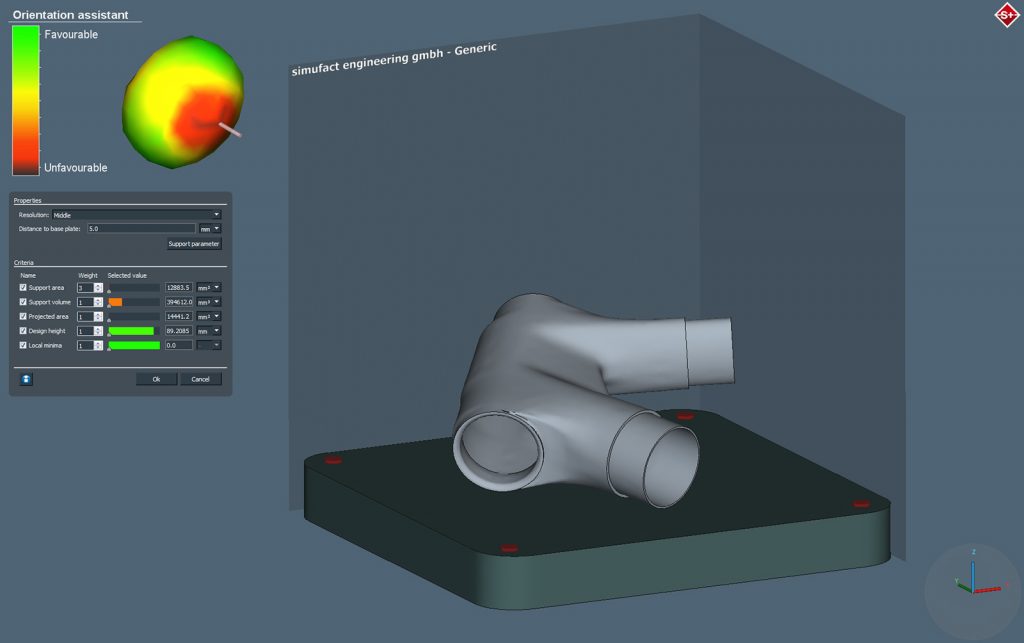
The software helps to identify the best build orientation, predict and completely compensate final part distortion automatically below a given threshold, optimise support structures automatically, identify overheated or not sufficiently heated zones and predict manufacturing issues such as cracks, shrinklines, and recoater contact before they occur. Users can also view the effects of preheated base plates or build spaces, and achieve more accurate simulation results for fully-nested base plates and build spaces.
Dr Gabriel McBain, Simufact’s Senior Director Product Management, stated, “Our new version 4 underlines our ambitions to provide the best overall process simulation package – concerning speed, accuracy, functionality, and usability.” Another focus point for the new release is to strengthen process chain capabilities, he added; “Our open software concept allows interfacing with third party solutions in the AM process chain, such as OEM build preparation software – Renishaw’s QuantAM is an example – and Materialise Magics.”
Materialise Magics 23: Enhanced metal AM functionality
Materialise NV, Leuven, Belgium, introduced the latest edition of its Magics software for AM: Magics 23 (Fig. 9). The updated software offers integrated simulation capabilities and automated support generation for metal Additive Manufacturing, and is said to offer improved ease-of-use while giving users more control. By offering more control and better integrated features, the company stated that its updated software allows users to process large data sets faster, spend less time on data preparation, and benefit from reduced powder consumption. Part quality has also been improved using fillets, which can be generated on a single edge.
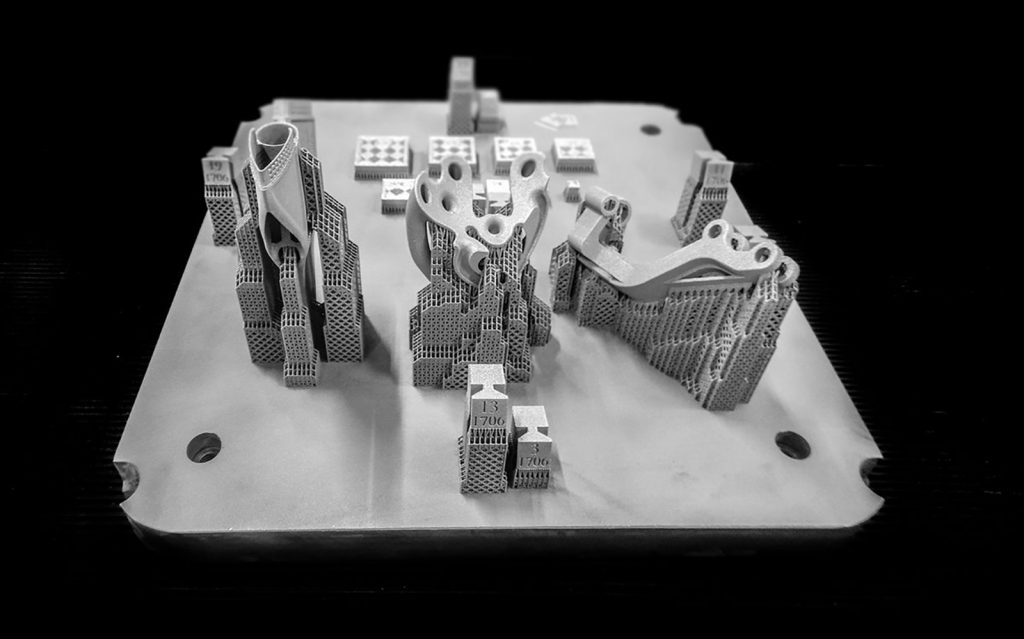
Materialise Magics 23 also introduces Data Matrix Label, a labelling feature that converts alphanumeric data from standard additively manufactured labels into a data matrix code that can be applied to individual parts. These smart tags are smaller and can be read by conventional data matrix scanners. Machine-readable tags are said to reduce human error and further automate the post-production process, supporting mass customisation.
Stefaan Motte, Vice President and General Manager of Materialise’s Software Division, stated, “With the introduction of Magics 23, we offer integrated automation features for metal 3D printing, including simulation and automatic support generation. This allows users to drive down cost by optimising their machine operations and reducing the number of build fails, all within their trusted Magics environment.”
ParaMatters: CogniCAD 2.0 topology optimiser for lightweighting
ParaMatters Inc., Ventura, California, USA, a provider of software for generative design, autonomous topology optimisation, parts consolidation and lightweighting, made available its second generation CogniCAD 2.0 platform during Formnext. Usable as both a cloud-based service and enterprise solution, CogniCAD 2.0 is the company’s second generation holistic, agnostic generative design solution. The tool works by first importing CAD files into the platform, and then defining loading and design criteria. Users can ‘within minutes’ obtain generative designs verified by built-in Finite-Element Analysis (FEA), ready for Additive Manufacturing in both STL and STEP formats. The platform is said to be capable of automatically generating ready-to-build, high-performance, lightweighted AM structures for aerospace, automotive and other mission-critical applications.
“We are taking full advantage of the convergence of advanced topology optimisation techniques, computational geometry, infinite computing power in the cloud and artificial intelligence to deliver the most powerful, affordable and impactful tool that unleashes the full potential of design for Additive Manufacturing,” commented Avi Reichental, ParaMatters Co-founder and board member. CogniCAD 2.0 also offers unique mesostructural design capabilities, which are available as a design service and can be used to create biomimicry or ‘nature inspired’ design for optimal structural infills, which can be mission-critical for certain AM processes (Fig. 10). “We are transforming the entire design-to-manufacturing process by making it possible for our cloud service to autonomously generate high-quality, CAD-agnostic and ready-to-manufacture, optimised lightweighted designs in minutes to a few hours,” explained Dr Michael Bogomolny, the company’s Chief Technology Officer and Co-founder.

The company is engaged in several complementary strategic partnerships. Among those customers and partners ParaMatters has made public are Ford, Volkswagen, GE, Renishaw, Techniplas, Stanley Black & Decker and AlphaStar. It also stated that it is developing advanced algorithms designed to enhance the overall digital thread and Additive Manufacturing capabilities. This includes a new cloud-based, generative design platform that automatically compiles lightweight and metamaterial lattice structures on-demand, based on size, weight, strength, style, materials and cost as specified by designers or engineers. “Our proprietary generative engine automatically delivers high performance and quality designs with minimal user input,” added Dr Bogomolny. “As a result, the entire design cycle is compressed from days to hours, and the quality of generative designs raised compared to what can be achieved manually” (Fig. 11).
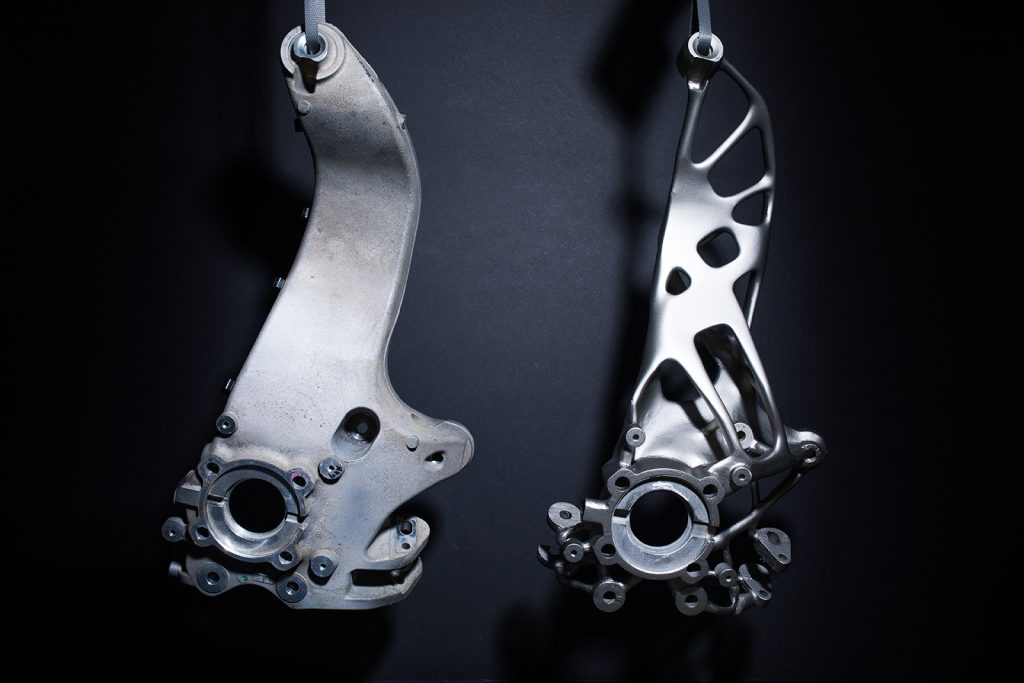
Strategy, adoption and collaboration on the journey toward industrialisation
GE Additive: Software strategy aims to simplify AM process
The Additive Manufacturing industry employs what seems like a vast array of build preparation tools, technologies, interfaces and licenses, which can create an additional layer of complexity for design engineers to manage and navigate when taking a part from CAD design to build job. A lack of interoperability due to conflicting interfaces, file types and user experiences can result in costly mistakes and delays for both the design engineering community and machine operators. During Formnext 2018, GE Additive outlined its software strategy, which centres on simplifying the AM process and enabling an interoperable workflow. The vision, according to the company, is to create a common experience through a secure, intuitive tool that reduces design iterations and speeds up the time taken to build a good additively manufactured part, according to the designer’s original intent.
The company stated that improving the build preparation workflow for AM, and lowering barriers to the technology’s adoption, will require: a simplified and secure build preparation workflow spanning the entire design-to-build process; the provision of interoperable build preparation services to CAD providers; high speed and accuracy, coupled with iterative thermal compensation; improved slicing performance; and the availability of an off-machine build processor.
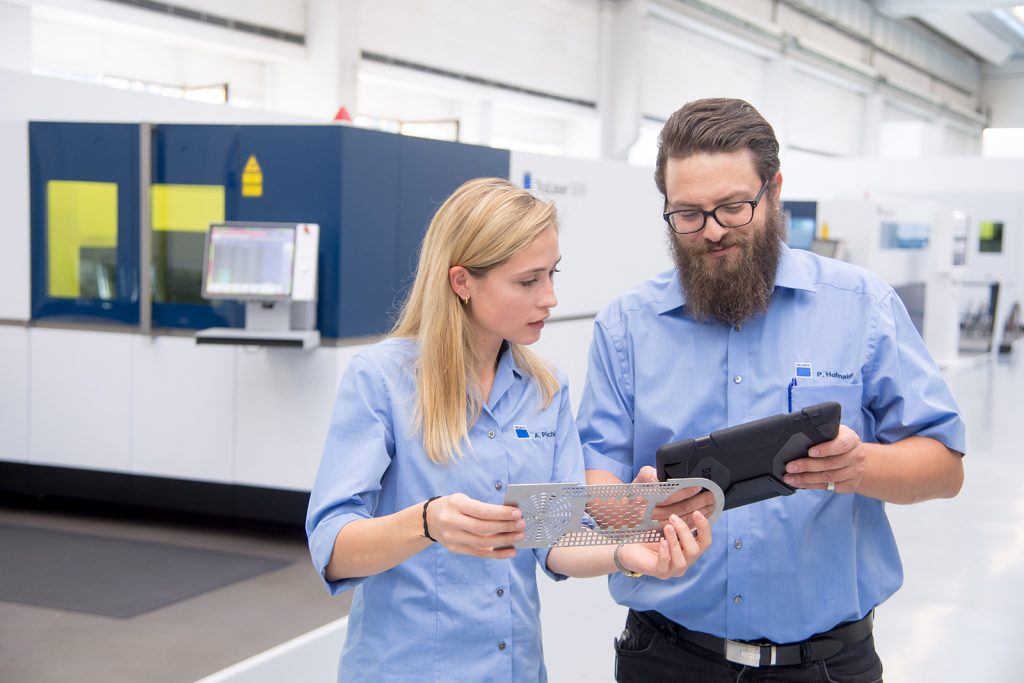
As part of its wider software strategy, GE Additive announced at Formnext several partnership agreements with leading AM software vendors Autodesk, PTC, Siemens PLM Software and Vera Security, through which it hopes to accelerate its development of interoperable, secure workflow solutions. The company also initiated a collaboration agreement with Dassault Systèmes. “We acknowledge that the industry needs to improve overall interoperability for design engineers,” stated Lars Bruns, Software Leader, GE Additive. Working with partners will enable GE to integrate build preparation services directly into the tools of design engineers, thereby saving time, reducing errors and enabling more accurate builds, while accelerating the adoption of AM through secure access to GE Additive machines.
Through its Formnext exhibit, the company actively sought feedback from its customers and end-users through interactive demos, and announced that it is recruiting interested parties to participate in beta testing through its Software Advisory and Technical Preview programme. “Feedback is a critical activity in the development of any software system, which is why we are demonstrating our current capabilities in Frankfurt,” stated Bruns during the show. “Over the next eight months, we’re seeking customer input from our users to help us inspect, adapt and iterate ahead of our commercial launch.” This end-user and customer feedback will expand upon extensive ongoing internal GE user research, combined with advanced technical modelling capabilities developed by both GE Additive’s GeonX team for simulation (following the company’s acquisition of GeonX in November 2017), and by GE Global Research teams for distortion compensation.
Volkswagen adopts metal AM technology from Additive Industries
It was announced during Formnext that Germany’s Volkswagen Group, one of the world’s largest automotive producers, has signed a long-term partnership with Additive Industries to additively manufacture advanced tooling and spare parts using the company’s metal Additive Manufacturing technology. It was reported that in September 2018, Additive Industries, Eindhoven, the Netherlands, had installed its latest fully-automated and integrated MetalFAB1 system at Volkswagen’s facility in the group’s hometown of Wolfsburg, Germany, with the first products now having been successfully produced after intensive training of the Volkswagen team.
“We see great potential for 3D metal printing of a broad range of car parts and tooling and have joined forces in Volkswagen internally to increase our facility seven fold to be prepared for the digital future,” stated VW’s Klaus-Jürgen Herzberg. Oliver Pohl, VW Department Manager, added, “The investment in the most modern 3D printing equipment allows us to continue to be front-runners in toolmaking and give our craftsmen access to the latest technology.”
“For Additive Industries, the partnership with Volkswagen, the world’s largest car maker, is a confirmation of our strategy to accelerate industrial Additive Manufacturing and focus on innovators in their markets,” commented Daan Kersten, CEO, Additive Industries. Jan-Cees Santema, Sales Director Europe for Additive Industries, continued, “We are proud to work closely with the Volkswagen team in Wolfsburg to execute on our roadmap for manufacturing excellence and expansion of the metal Additive Manufacturing footprint.”
Trumpf reveals its approach to industry 4.0 and metal Additive Manufacturing
Trumpf, Ditzingen, Germany, demonstrated how the use of connected metal Additive Manufacturing machines can boost transparency in digitalised factories. Trumpf has already employed digitalisation and other industry 4.0 solutions in its workflows for other manufacturing technologies, and stated that it is now transferring these solutions to its TruPrint series of AM machines for workflow optimisation.
In November, to enable Formnext attendees to experience the advantages of connected manufacturing first hand at its booth, Trumpf displayed its TruPrint machines connected to a Manufacturing Execution System (MES) and a smart ordering platform. These two solutions offer employees mobile, real-time access to the machines’ process data and pending orders, and facilitates planning and paperless management of production, which boosts transparency, flexibility and ultimately manufacturing productivity.
“Trumpf is a leader in Industry 4.0,” stated Tobias Baur, Trumpf General Manager Additive Manufacturing with responsibility for technology. “We also show how the 3D printing process chain can be completely digitalised – from tender preparation to printed component.”
To establish additive technologies in industrial manufacturing, Trumpf is continuing to focus on ensuring that its systems are highly reliable and efficient. “Otherwise, 3D printing methods can’t compete with conventional technologies such as milling and casting,” stated Thomas Fehn, Trumpf General Manager Additive Manufacturing with responsibility for sales.
Trumpf brings more than fifty years of experience in machine tools to the table, and is somewhat unique as an Additive Manufacturing machine maker in that it offers all components of the technology under one roof: laser beam sources, optics, machines and post-processing technologies such as milling. “We have everything you need for 3D printing,” added Fehn. “This is highly advantageous when industrialising these processes because we have access to the technologies that best fit our customers’ needs.”
In order to fully utilise Additive Manufacturing as a mass-production technology, Trumpf stated, AM systems must be automated. It is for this reason that the new TruPrint 5000 incorporates an automated process start, reducing manual system preparation activities, as well as saving time and improving both quality and productivity.
GKN Powder Metallurgy and EOS form technology partnership to industrialise metal Additive Manufacturing
GKN Powder Metallurgy, the world’s largest producer of sintered metal parts, announced a strategic partnership with EOS, long recognised as a global technology leader at the forefront of the industrial Additive Manufacturing of both metals and polymers. In a panel discussion at Formnext, the two companies revealed that together they have designed a new, high-productivity process for laser-based metal Additive Manufacturing that they believe will reduce production time by 70% and overall cost by up to 50%.
“We’re thinking differently about what’s possible in manufacturing; metal 3D printing and rapid prototyping have become a formidable part of our business,” stated Peter Oberparleiter, CEO of GKN Powder Metallurgy. “This collaboration makes laser metal 3D printing a viable long-term solution for manufacturers across the board that require fast delivery turnaround and could benefit from the high degree of design freedom that comes with laser 3D printing. Our customers will be able to produce higher quality parts faster than ever before, with absolutely no tooling.”
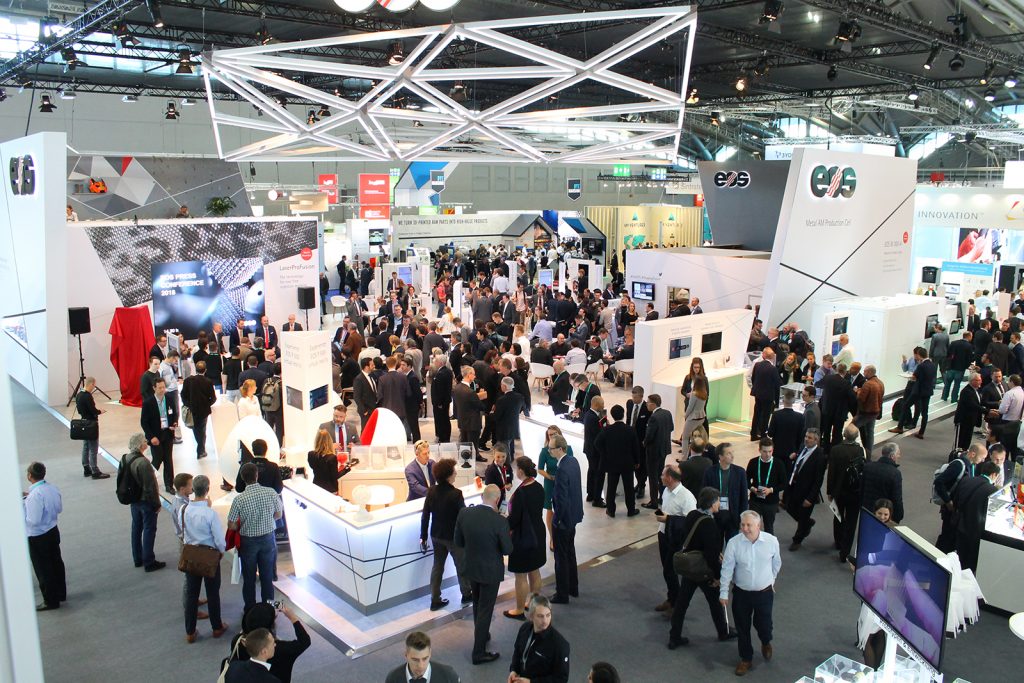
It was stated that the combination of an innovative metal powder from GKN, EOS StainlessSteel 316L VPro, and EOS’s unique process and Additive Manufacturing expertise, make it possible to create high-performance parts designed for end-use at scale.
“In order to expand our footprint in the automotive industry, we were looking for a strong partner with a high level of expertise in the field of steels and typical industry grade materials, combined with a proven track record of further industrialising technologies together with customer applications,” stated Dr Adrian Keppler, EOS CEO. “We found a perfect partner in GKN Powder Metallurgy. Based on this partnership, our customers will benefit from higher build speeds and lower material costs resulting in significantly optimised cost -per-part. This is going to lower the entry barrier and will enable completely new application fields.”
Conclusion
Whilst this report does not hope to cover all of the innovations in productivity and efficiency presented during Formnext – including new peripheral technologies for post-processing and more – it is clear from this sampling that the industry recognises the need to enhance the productivity and efficiency of metal AM technology if it is to compete as a production technology at volume. It is no longer enough to produce the most enticing or the most exciting new Additive Manufacturing technology; those companies with an eye on industrialisation must now be ready to prove their machine’s capabilities in a factory setting. Likewise, software companies must increasingly gear their solutions toward interoperability and time saving for the production workflow.
If at Formnext 2017 metal AM began the shift from hype to reality, then it was at Formnext 2018 that the industry set about addressing that reality. It has become increasingly clear over the course of the year that large segments of the wider industrial community are ready to embrace metal Additive Manufacturing as a production technology, but that significant challenges remain for its use in serial parts manufacturing. In addition to promoting its adoption, the AM industry must now be ready to facilitate that adoption by making available factory-ready technologies across the entire process chain, from design to finishing. Recent decisions to adopt metal AM technology by major companies such as Volkswagen indicate that efforts in this area offer significant rewards for the industry.
Author
Emily-Jo Hopson
Assistant Editor, Metal AM magazine
Inovar Communications Ltd.
11 Park Plaza
Battlefield Enterprise Park
Shrewsbury SY1 3AF, UK
[email protected]







